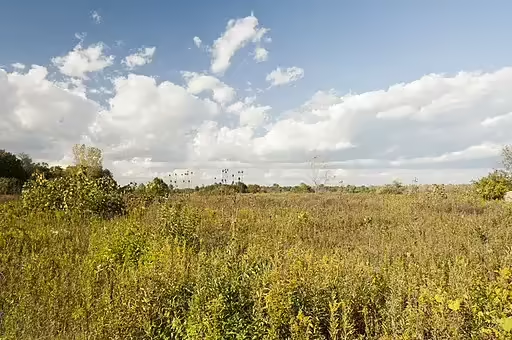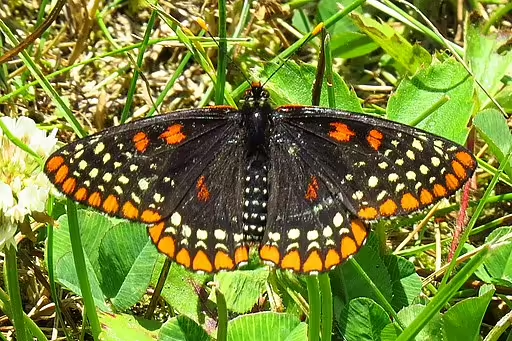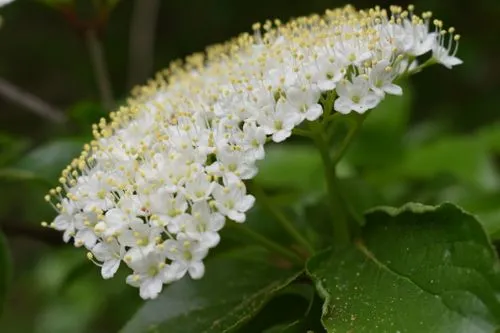Table of Contents for Hard-leaf Flat-top Goldenrod (Solidago rigida)
Hard-leaf Flat-top Goldenrod (Solidago rigida) is a herbaceous perennial that is native to the mid-western and eastern United States. This species is a host to the baltimore checkerspot (Euphydryas phaeton) and several moths. Growing from 1 foot to 5 feet tall, this species grows in prairies, glades, barrens, thickets, and mixed flatwoods. The yellow flowers bloom from August to October and the plant is hardy in zones 3-9.
Taxonomy and Naming of Hard-leaf Flat-Top Goldenrod (Solidago rigida)



Taxonomy
Hard-leaf Flat-top Goldenrod (Solidago rigida) was originally named and described by Carl Linnaeus, in Species Plantarum (1753). It has kept this same name since and is a member of the Aster Family (Asteraceae).
Varieties
- Solidago rigida subsp. glabrata: mainly south-central and southeastern United States, stems are glabrous
- Solidago rigida subsp. humilis: mid-western United States and Canada, plants are 1.2 in (3 cm) to 2.5 in (7 cm) in height
- Solidago rigida subsp. rigida: mid-western and eastern United States and Ontario in Canada, plants are 2.25 in (6 cm) to 6 in (15 cm) in height
Meaning of the Scientific and Common Names
Scientific Name
The genus name, Solidago, derives from the Latin words, Solidus and ago, which together mean to make (ago) whole (Solidus). This meaning comes from the medicinal uses of the plant. The species name, rigida, is Latin for rigid, presumably in reference to the stem.
Common Name and Alternative Names
The common name comes from the rigid leaves. Some other common names include stiff goldenrod (Stuckey and Pringle 1997) and stiff-leaved goldenrod (Glattstein 1991).
Physical Description

- Plant Type: This plant is a herbaceous perennial.
- Height: 1 ft (0.3 m) to 5 ft (1.5 m)
- Stem: The stems are erect, multi-stemmed, and glabrous to pubescent (Flora of North America).
- Leaves: The leaves are alternate, with basal and cauline leaves, ovate to rhombic, upper cauline sessile, and entire to crenate/serrate margins. They are 3 in (8 cm) to 12 in (30.5 cm) long and 1 in (2.5 cm) to 2 in (5 cm) wide.
- Flower color: yellow
- Blooming period: This plant blooms from August to October.
- Fruiting type and period: This plant has achenes that mature in the late fall and winter.
Range of Hard-leaf Flat-top Goldenrod in the United States and Canada



This goldenrod species has three subspecies, one of which, Solidago rigida subsp. glabrata is native to the south-central and eastern United States, another, Solidago rigida subsp. humilis is native to the mid-western United States and Canada, and the last Solidago rigida subsp. rigida is native to the mid-western and eastern United States and Ontario in Canada. Subspecies glabrata is considered to be rare in the states of Georgia, Missouri, North Carolina, South Carolina, Texas, and Virginia. Subspecies rigida is considered to be rare in Connecticut, Maryland, New Jersey, New York, North Carolina, Pennsylvania, South Carolina, Virginia, West Virginia, and the province of Ontario.
Habitat

This species grows in open areas such as prairies, glades, savannas, meadows and dry areas on calcareous soils (Flora of North America), mesic upland tallgrass prairie (Maycock and Eahselt 1997), diabase glades and barrens (Levy and Wilbur 1990 and Weakley and Poindexter 2012), mixed pine-deciduous flatwoods (Fox, et al 1952), cottonwood forests (Keammerer, et al 1975) and thickets (Palmer and Steyermark 1935).
Hosted Insects

This goldenrod, like a lot of other goldenrods, is a host to wavy-lined emerald (Synchlora aerata). The genus in general is a host to the Baltimore Checkerspot (Euphydryas phaeton) and black swallowtail (Papilio polyxenes). A leaf-roller (Depressaria pulvipenella) lives in the rolled leaves of this species (Coquillett 1883).
Other Supported Wildlife

This species is a nectar source to other butterflies, skippers, bees, and wasps during the growing season. It is especially important since it provides a nectar source in the late season. This species also supports a bee (Panurginus piercei) (Stevens 1919).
Frequently Asked Questions
Does this plant have any ethnobotanical uses?
The Native American Ethobotanical Database does not specifically cite this species, but Solidago in general has been used for pain relief, coughs, stomach ailments, and heart medicine.
How is this plant distinguished from other Goldenrods?
This goldenrod is similar to the prairie flat-top goldenrod (Solidago ptarmicoides) and the shiny goldenrod (Solidago nitida), but both of these species have linear to lanceolate leaves versus the ovate leaves of this goldenrod.
Is this plant invasive?
This has not been noted as being weedy.
Gardening with Hard-leaf Flat-top Goldenrod

Hardiness
This species is hardy in zones 3-9. If your garden is within these zones and you have the right growing conditions (soil, moisture and exposure), you may well be able to grow this plant. However, if planted outside of its range, the hosted species may not recognize the plant or be harmed by ingesting a different species with an unfamiliar chemical composition.
Optimal Conditions
This species enjoys full sun to part-shade in medium to dry well-drained circumneutral to high pH soils.
References
- Coquillett, D.W. 1883. The leaf-rollers of Illinois. Papilio 3: 97-103.
- Fox, William B., R.K. Godfrey, H.L. Blomquist. 1952. Notes on dsitribution of North Carolina plants. III. Rhodora 54: 165-182.
- Glattstein, Judy. 1991. The Daisies of Autumn. Arnoldia 51(2): 23-31.
- Keammerer, Warren R., W. Carter Johnson, and Robert L. Burgess. 1975. Floristic analysis of the Missouri River bottomland forests in North Dakota. Canadian Field-Naturalist 89(1): 5-19.
- Levy, F. and Robert L. Wilbur. 1990. Disjunct populations of the alleged serpentine endemic, Aster depauperatus (Porter) Fern., on diabase glades in North Carolina. Rhodora 92: 17-21.
- Maycock, Paul F. and Dianne Eahselt. 1997. An inventory of ecologically significant natural vegetation in the province of Ontario: 1. Essex County. Candian Field-Naturalist 101: 474-486.
- Palmer, Ernest J. and Julian A. Steyermark. 1935. An Annotated Catalogue of the Flowering Plants of Missouri. Annals of the Missouri Botanical Garden 22: 375-758.
- Stevens, O.A. 1919. The Panurgine Bees of North Dakota and A New Epeolus. The Canadian Entomologist 51: 205-210.
- Stuckey, Ronald L. and James S. Pringle. 1997. Common Names of Vascular Plants Reported by C.S. Rafinesque in an 1819 Descriptive Outline of Four Vegetation Regions on Kentucky. Transactions of the Kentucky Academy of Science 58: 9-19.
- Weakley, A.S. and the Southeastern Flora Team. 2022. Flora of the southeastern United States. University of North Carolina Herbarium, North Carolina Botanical Garden.
- Weakley, A.S. and D.B. Poindexter. 2012. A new species of Marshallia (Asteraceae, Helenieae, Marshalliinae) from mafic woodlands and barrens of North Carolina and Virginia. Phytoneuron 2012-105: 1-17.


